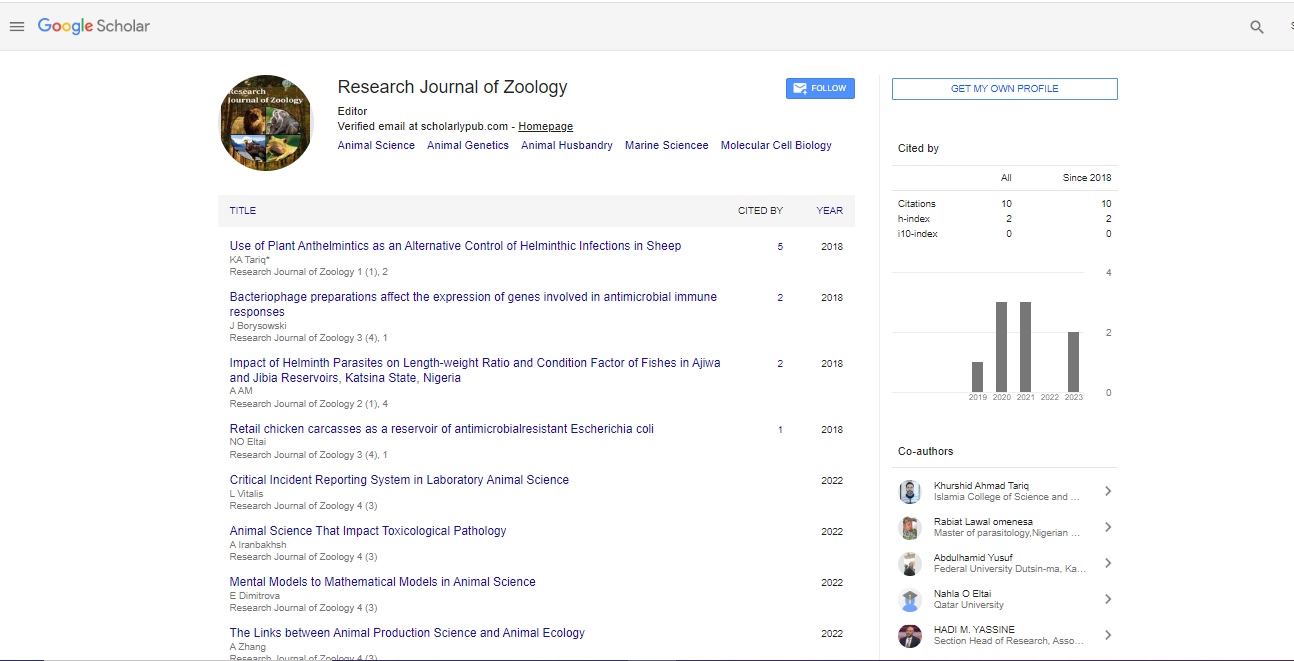Opinion Article, Res J Zool Vol: 5 Issue: 1
Morphology and Ecological Significance of Barnacles
Simrin Jalim*
Department of Animal Science, Islamic Azad University, Karaj, Iran
*Corresponding Author: Simrin Jalim
Department of Animal Science
Islamic Azad University, Karaj, Iran
E-mail: simrinjalim12@gmail.com
Received date: 20-Feb-2023, Manuscript No. RJZ-23-95680;
Editor assigned date: 22-Feb-2023, PreQC No. RJZ-23-95680 (PQ);
Reviewed date: 09-Mar-2023, QC No. RJZ-23-95680;
Revised date: 16-Mar-2023, Manuscript No. RJZ-23-95680(R);
Published date: 23-Mar-2023, DOI: 10.4172/Rjz.1000078.
Citation: Jalim S (2023) Morphology and Ecological Significance of Barnacles. Res J Zool 5:1.
Description
Barnacles are a group of marine crustaceans that are often overlooked due to their small size and inconspicuous appearance. From their interesting anatomy to their ecological significance, barnacles are truly nature's tiny mariners that deserve our attention and admiration. Barnacles belong to the class Cirripedia and are characterized by their hard shells made of calcium carbonate, which protect their soft bodies. They are found in a wide range of marine habitats, from intertidal zones to deep-sea environments, and can attach themselves to various substrates such as rocks, shells, and even ships' hulls. Barnacles have a distinctive appearance, with their shell resembling a volcano or a miniature volcano, which is composed of several plates arranged in a series of overlapping layers. One of the most intriguing aspects of barnacles is their unique reproductive system. Unlike most crustaceans, barnacles are hermaphrodites, meaning they have both male and female reproductive organs. However, they do not self-fertilize and instead they have to copulate with another barnacle to reproduce. Barnacles extend long feathery appendages called cirri from their shells, which they use to capture planktonic food particles from the water. These cirri are also used for mating, as barnacles engage in a complex and precise courtship dance where they transfer sperm packets to each other's bodies.
Barnacles are filter feeders and their feeding habits have significant ecological implications. By capturing plankton from the water, barnacles play a crucial role in the marine food web as they provide food for a wide range of organisms including fish, whales, and seabirds. They also compete with other filter feeders for resources, and their abundance and distribution can affect the overall biodiversity and ecosystem dynamics in marine environments. Barnacles have evolved a remarkable ability to adapt to their environment and survive in challenging conditions. For example, they have developed specialized adaptations to cope with the stresses of intertidal zones, where they are exposed to extreme changes in temperature, salinity, and desiccation during low tide. Barnacles have a tough outer shell that helps prevent water loss, and they can retract their cirri and close their shells tightly to reduce exposure to air and retain moisture. Some barnacles even produce a type of natural glue that helps them adhere more securely to their substrate, preventing them from being washed away by waves or dislodged by other organisms.
Barnacles also have a relationship with other marine organisms. They often form complex communities called barnacle fouling, where multiple species of barnacles, along with other encrusting organisms such as mussels, sponges, and algae, attach to the same substrate and compete for space and resources. These fouling communities can have both positive and negative effects on marine ecosystems. On one hand, they provide a habitat for a diverse array of organisms and increase local biodiversity. On the other hand, they can cause problems for human-made structures such as ships and underwater installations, as they can accumulate in large numbers and increase drag, leading to increased fuel consumption and maintenance costs. For example, their unique reproductive system has provided insights into the evolution of sexual reproduction and the costs and benefits of hermaphroditism. Barnacles have also been used as model organisms in studies on larval settlement and recruitment, as their larval stage is free-swimming and can disperse over long distances before settling down and undergoing metamorphosis.
 Spanish
Spanish  Chinese
Chinese  Russian
Russian  German
German  French
French  Japanese
Japanese  Portuguese
Portuguese  Hindi
Hindi 
